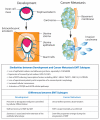Tracking the intermediate stages of epithelial-mesenchymal transition in epithelial stem cells and cancer
- PMID: 21862874
- PMCID: PMC3218599
- DOI: 10.4161/cc.10.17.17188
Tracking the intermediate stages of epithelial-mesenchymal transition in epithelial stem cells and cancer
Abstract
Epithelial-mesenchymal transition (EMT) is an essential developmental program that becomes reactivated in adult tissues to promote the progression of cancer. EMT has been largely studied by examining the beginning epithelial state or the ending mesenchymal state without studying the intermediate stages. Recent studies using trophoblast stem (TS) cells paused in EMT have defined the molecular and epigenetic mechanisms responsible for modulating the intermediate "metastable" stages of EMT. Targeted inactivation of MAP3K4, knockdown of CBP, or overexpression of SNAI1 in TS cells induced similar metastable phenotypes. These TS cells exhibited epigenetic changes in the histone acetylation landscape that cause loss of epithelial maintenance while preserving self-renewal and multipotency. A similar phenotype was found in claudin-low breast cancer cells with properties of EMT and stemness. This intersection between EMT and stemness in TS cells and claudin-low metastatic breast cancer demonstrates the usefulness of developmental EMT systems to understand EMT in cancer.
© 2011 Landes Bioscience
Figures


Similar articles
-
Trophoblast stem cell maintenance by fibroblast growth factor 4 requires MEKK4 activation of Jun N-terminal kinase.Mol Cell Biol. 2009 May;29(10):2748-61. doi: 10.1128/MCB.01391-08. Epub 2009 Mar 16. Mol Cell Biol. 2009. PMID: 19289495 Free PMC article.
-
MAP3K4 Controls the Chromatin Modifier HDAC6 during Trophoblast Stem Cell Epithelial-to-Mesenchymal Transition.Cell Rep. 2017 Mar 7;18(10):2387-2400. doi: 10.1016/j.celrep.2017.02.030. Cell Rep. 2017. PMID: 28273454 Free PMC article.
-
MAP3K4/CBP-regulated H2B acetylation controls epithelial-mesenchymal transition in trophoblast stem cells.Cell Stem Cell. 2011 May 6;8(5):525-37. doi: 10.1016/j.stem.2011.03.008. Cell Stem Cell. 2011. PMID: 21549327 Free PMC article.
-
Reprogramming during epithelial to mesenchymal transition under the control of TGFβ.Cell Adh Migr. 2015;9(3):233-46. doi: 10.4161/19336918.2014.983794. Epub 2014 Nov 17. Cell Adh Migr. 2015. PMID: 25482613 Free PMC article. Review.
-
Epithelial-mesenchymal transition process during embryo implantation.Cell Tissue Res. 2022 Apr;388(1):1-17. doi: 10.1007/s00441-021-03574-w. Epub 2022 Jan 13. Cell Tissue Res. 2022. PMID: 35024964 Review.
Cited by
-
Clusterin and Its Potential Regulatory microRNAs as a Part of Secretome for the Diagnosis of Abnormally Invasive Placenta: Accreta, Increta, and Percreta Cases.Life (Basel). 2021 Mar 24;11(4):270. doi: 10.3390/life11040270. Life (Basel). 2021. PMID: 33805203 Free PMC article.
-
Mutations and deregulation of Ras/Raf/MEK/ERK and PI3K/PTEN/Akt/mTOR cascades which alter therapy response.Oncotarget. 2012 Sep;3(9):954-87. doi: 10.18632/oncotarget.652. Oncotarget. 2012. PMID: 23006971 Free PMC article. Review.
-
How apoptosis and epithelial-to-mesenchymal transition are nested in EGFR inhibitors resistance in lung cancer.J Thorac Dis. 2019 Jan;11(1):47-49. doi: 10.21037/jtd.2018.12.117. J Thorac Dis. 2019. PMID: 30863568 Free PMC article. No abstract available.
-
Epithelial-Mesenchymal Transition in Pancreatic Cancer: A Review.Biomed Res Int. 2017;2017:2646148. doi: 10.1155/2017/2646148. Epub 2017 Dec 12. Biomed Res Int. 2017. PMID: 29379795 Free PMC article. Review.
-
Plausibility of trophoblastic-like regulation of cancer tissue.Cancer Manag Res. 2019 May 31;11:5033-5046. doi: 10.2147/CMAR.S190932. eCollection 2019. Cancer Manag Res. 2019. PMID: 31213916 Free PMC article.
References
Publication types
MeSH terms
Substances
Grants and funding
LinkOut - more resources
Full Text Sources
Medical
Research Materials
Miscellaneous
